|
 |
■ Bioresources information is available at the following URLs
|
 |
|
Introduction to Resource Center <No. 53> Collection, Preservation, and Practical Use of Mushroom Genetic Resources
Akira Nakagiri, Director, Fungus/Mushroom Resource and Research Center,
Faculty of Agriculture, Tottori University
Current Standing of the Fungus/Mushroom Resource and Research Center and
the Tottori University Fungal Culture Collection |
|
The Fungus/Mushroom Resource and Research Center (FMRC) was established in 2005 and is affiliated with the Faculty of Agriculture, Tottori University. The FMRC is the only education and research facility for mushroom genetic resources in Japan. It is involved in fundamental research, applied research, and education focusing on the practical use of eumycetes, particularly those mushrooms producing large fruiting bodies (Basidiomycetes and Ascomycetes). The FMRC also serves as a genetic resource bank, and possesses the Tottori University Fungal Culture Collection (TUFC), which mainly consists of mushroom strains. When the FMRC was established, the Tottori Mycological Institute, affiliated to the Japan Kinoko Research Center Foundation in Tottori city, transferred approximately 3,000 fungal cultures to the FMRC. Since then, the FMRC has collected and preserved several mushroom strains, including those transferred.
As of April 2014, the FMRC has preserved 467 genera, 1,277 species, and 8,131 strains—making it one of the largest collections in the world. In June 2012, the FMRC began to distribute strains to researchers outside the university. Simultaneously, a strain database, the TUFC Culture Online Catalogue (hereafter referred as the Catalogue) was made available to the public. At present, 231 genera, 424 species, and 846 strains have been made available to the public as distributable strains, and the qualities of these open-access strains are being strictly controlled. The FMRC will continually update and increase the number of distributable strains available online.
To control the quality of the available strains, strains are identified and confirmed using the base sequences of the external transcribed spacer region of nuclear rDNA, and the D1/D2 domain of large-subunit rDNA. The sequence data is available on the Internet. Since the Catalogue is equipped with the Basic Local Alignment Search Tool search function, a user can use the Catalogue to select a strain whose sequence is similar to the user’s target sequence, as well as to identify a strain. The portions of mushrooms that are used to isolate genetic and protein material are dried and preserved at the herbarium in the FMRC. These are cataloged as the Tottori University Mycological Herbarium (TUMH) specimens and are managed through a strain database. In 2013, 230 TUMH strains were distributed to 10 research organizations. We hope that the TUFC will be recognized by a large number of researchers and academicians, and that the available mushroom genetic resources will be used extensively in the future.
As of April 2013, the FMRC was reorganized to include five divisions (Division of Genetic Research Diversity, Division of Bioresource Preservation and Evaluation, Division of Mushroom Cultivation, Division of Functional Fungal Physiology, and Pharmacology, and Division of Applied Fungal Chemistry), comprising 14 professors, assistant professors, and associate professors (Fig. 1). Owing to this organizational change, a system was established to effectively pursue research focusing on the practical use of the preserved resources. In particular, we will develop cultivation techniques for the production of fruiting bodies (mushrooms) from the preserved mushroom strains, and attempt to discover physiologically active substances contained in fruiting bodies instead of in vegetative mycelia and use the discovered components. An example of such an accomplishment is the discovery of gymnopilin, a poisonous substance obtained from the fruiting body of artificially cultivated Gymnopilus junonius (a poisonous mushroom). Gymnopilin was shown to possess unknown physiological activities, such as the activation of neurons, relaxation of the vascular smooth muscle, and inhibition of the acetylcholine receptor function. Owing to these functionalities, Gymnopilin is expected to be used in pharmaceutical products in the future (Fig. 2). |
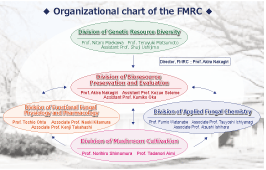
Fig. 1. Organizational chart of the FMRC and its divisions
The TUFC is managed by the Division of Bioresource Preservation and Evaluation.
|
|
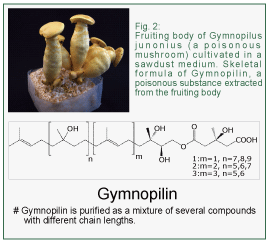 |
Creation of New Resources |
|
The FMRC currently lays emphasis on the following activities in order to enrich and utilize new resources: |
-
The FMRC aims to collect and add those strains of mushrooms which have not yet been preserved to the TUFC in order to improve its quality. In 2013, the FMRC collected, preserved, and added to the TUFC, 142 genera, 218 species, and 334 strains of fungi and mushrooms. In particular, the FMRC will make an effort to collect cultures of ectomycorrhizal basidiomycetes, which present difficulties in cultivation in artificial media, as well as cryopreservation. In order to achieve this, we have been improving the existing preservation methods and developing new ones. We will continually control the quality of preserved strains and increase the number of strains that need to be made accessible to the public. We will strive to ensure that the TUFC is essential for researchers focusing on a wide range of disciplines, including fundamental and applied research.
The FMRC aims to obtain extracts from fruiting bodies and fungal cultures and to establish a library for these extracts so that preserved strains can be utilized (Fig. 3).
|
|
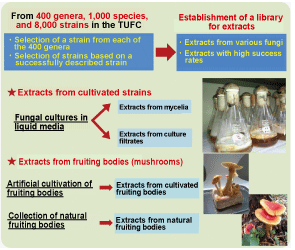
Fig. 3. Establishment of a library for extracts from cultivated strains and fruiting bodies (mushrooms) |
Extracts from a cultivated strain are obtained as follows: (1) TUFC strain is cultivated in a liquid medium, (2) the liquid medium is separated into mycelium and culture filtrates, and (3) an extract is obtained from both the mycelium and the culture filtrate. The FMRC will select a strain from each of the 400 genera of preserved fungi in order to establish a library for the extracts. The FMRC has produced extracts from cultivated and natural fruiting bodies in order to obtain physiologically active substances peculiar to fruiting bodies, which are not contained in the mycelia. The cultivated fruiting bodies are obtained by artificially cultivating TUFC strains, while the natural fruiting bodies are collected from nature. Both types of fruiting bodies are freeze-dried, and extracts are obtained from the freeze-dried samples using various solvents. The library for extracts will be used to search for lead compounds that might be useful for drug development, and active substances that might be useful for the food and agricultural industries. Currently, the Division of Functional Fungal Physiology and Pharmacology, and the Division of Applied Fungal Chemistry have addressed various research and development activities and are pursuing joint studies with medical research facilities in the university as well as with bio-venture companies. |
Goals to Have a Characteristic Collection |
The FMRC functions as an educational organization, a research organization, and a genetic resource bank. Although the genetic resource bank is still quite small now, we aim to own a characteristic collection and be labelled as a "bank specialized in mushrooms". Mushrooms are undeveloped resources. One of the FMRC’s missions is to improve the quality of the TUFC further in order to increase the number of useable resources. Resources become valuable when they are used. For example, in Tottori University, many researchers use fungi as research material, and the FMRC makes every effort to provide easy-to-use resources for researchers affiliated to and from outside the university, to facilitate the use of preserved mushroom genetic resources by researchers in various fields, including fundamental and applied research.
|
|
|
Assessing the Vulnerability of WordPress using iThemes Security |

WordPress is a popular content management system (CMS) that is extensively used around the world. However, the large user base also leads to a greater exposure to security risks, and there have been numerous reports of damage caused by malicious access to websites created using WordPress. Thus, countermeasures to reduce such security risks are essential in order to safely maintain a website which uses WordPress. In this edition, we introduce a free plugin called "iThemes Security" that can assess the vulnerability of a live WordPress site.
|

Installing and performing the initial configuration of iThemes Security
1. Click on [Plugin] on the left-hand side menu in the administration screen, and then click on [Add New] (Fig. 1-A).
2.Search for the plugin using the term “iThemes Security” and click on [Install Now] (Fig. 1-B).
3.From the list of installed plugins, activate iThemes Security and click on the [Secure Your Site Now] button on the message shown at the top of the screen (Fig. 2).
|
|
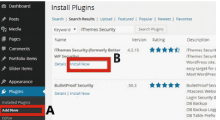
Fig. 1. Installing iThemes Security

Fig. 2. iThemes Security configuration message |
4. 4. On the initial configuration screen (Fig. 3), click on the corresponding buttons to perform: (1) a database backup (2) permit changes to the WordPress configuration files, and (3) enable the recommended settings. (Step (4)—sending usage information to the developers—is optional.)
Fig. 3. Initial configuration screen |
|
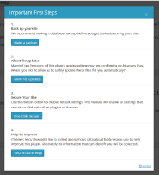 |

Checking for Vulnerabilities
After the initial configuration of iThemes Security, the vulnerability assessment of the WordPress site is also complete. To view the assessment, click on [Dashboard] in the [Security] menu on the left-hand side of the administration screen. The "Security Status" lists detected vulnerabilities categorized into four levels: "High," "Medium," "Low," and "Completed" (Fig. 4).
|
| |
|
The ratings reflect the level of risk, frequency of occurrence, and magnitude of impact for each vulnerability. While all vulnerabilities should be addressed, the ones rated "High" are the most fundamental and significant risks (see Table 1). |
|
|
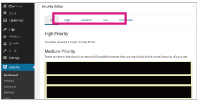
Fig. 4. Security Status (partially shown) |
|
Table 1. Examples of detected vulnerabilities
| Priority |
Content |
Reason for applying a fix |
| High |
The website is not performing any scheduled database backups. |
The contents cannot be recovered in the event of an emergency. |
| High |
The default "admin" user exists in the system. |
There could be unauthorized access because the login credentials can be easily guessed. |
| Medium |
Database tables have the default "wp_" prefix. |
The table name can be easily guessed by an unauthorized user. |
| Medium |
The administration screen is available for login 24 hours. |
The risk of unauthorized access can be reduced by disabling login during hours where administrators are unlikely to login, such as at midnight. |
|

iThemes Security provides a wide range of security countermeasures in addition to the basic ones, from limiting the number of login attempts to more advanced countermeasures such as changing the database table prefix. It is advisable to apply appropriate security measures after performing the vulnerability check to ensure that your important website is secure.
(Kyohei Matsuno) |
|
|